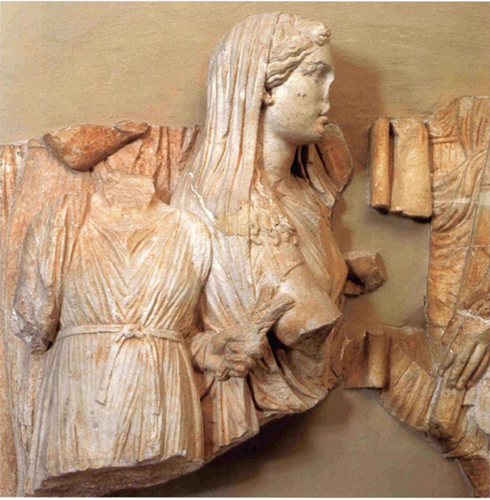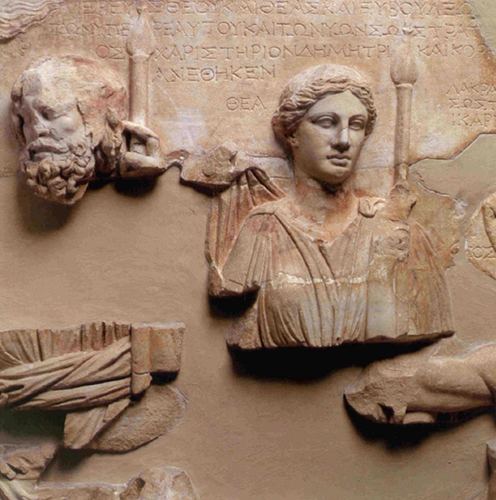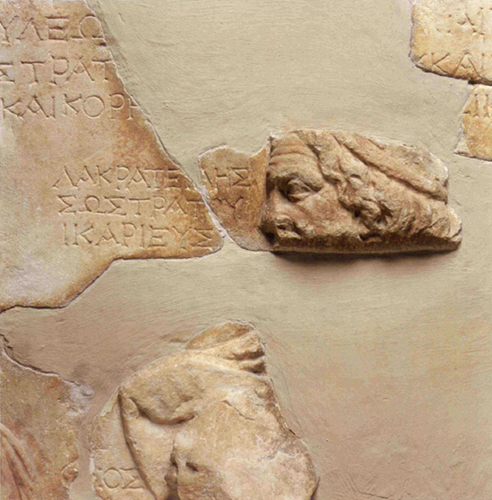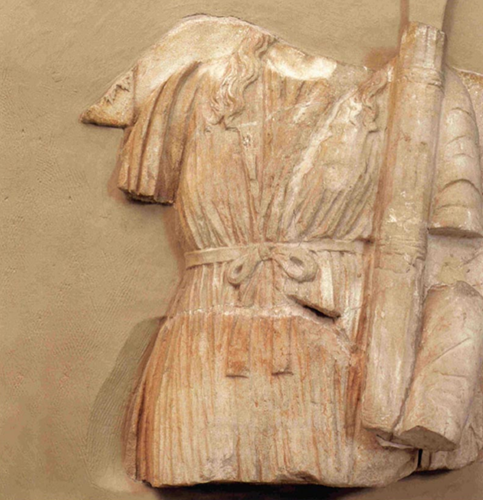The Lacrateides relief
In the fourth century, worshippers began dedicating reliefs showing themselves and their families in the presence of the goddesses of Eleusis. The relief of Lacrateides is a typical example and one of the fascinating artefacts in the Archaeological Museum of Eleusis. Sixty fragments were found in the courtyard of the Plutoneion and allowed researchers to reconstruct the relief (which was initially 2.5 metres long and 1.5 metres high).

It is generally accepted that the relief depicts an assembly of Eleusinian deities. Demeter sits in the left corner. She wears a veil and delivers a sheaf of wheat to young Triptolemus, who is depicted standing on the chariot with the winged dragons. Persephone also stands in front of her mother, holding a torch, while the bearded man with the tousled hair and the sceptre behind her is Pluton (readily identified by the inscription next to his face). The couple that follows has been interpreted as the chthonic versions of Pluton and Persephone, and the use of the names “God and Goddess" (ΘΕΟΣ, ΘΕΑ) stems from the tendency of the Greeks not to name the terrible gods of the Underworld. The man wears a mantle, sits on a throne, and holds a sceptre. The woman stands and lifts her veil from her right shoulder.

The benefactor, Lakrateides, is depicted to the right of the chthonic deities. He was the son of Sostratos from the Attic deme Ikaria (present-day Dionysos, north of Athens). Lakrateides was a priest of God, the Goddess and Eubouleus. The latter is probably the young man wearing a belted tunic on the right end of the relief.

The young sons of Lakrateides, Sostratos and Dionysios, are depicted as Iacchus holding sheaves of wheat that may represent the “dragmata”, the handfuls of “civilised nourishment” (wheat) each initiate carried to the sanctuary during the initiation process. The woman behind the child on the left side of the relief is Dionysia, the wife of Lakrateides. Other researchers interpret the child as Plutus and consider the female figure to be the personification of Eleusis.
The relief dates to around 100 BCE.

Bibliography
Kourouniotis, Konstantinos. Eleusis: a guide to the excavations and the museum, Athens: The Archaeological Society at Athens, 1936.
Mylonas, George. Eleusis and the Eleusinian Mysteries, London: Routledge, 1962.
Papangeli, Kalliopi. Eleusis: the archaeological site and the museum, Athens: Omilos Latsi, 2002.
Image sources:
Rijksmuseum - Anonymous (c. 1890-1895): The Ploutonion in Eleusis.
Archaeological Museum of Eleusis - Unknown (c. 100 BCE): Lacrateides relief (Demeter).
Archaeological Museum of Eleusis - Unknown (c. 100 BCE): Lacrateides relief (Theos and Thea).
Archaeological Museum of Eleusis - Unknown (c. 100 BCE): Lacrateides relief (Lacrateides).
Archaeological Museum of Eleusis - Unknown (c. 100 BCE): Lacrateides relief (Iacchus).


